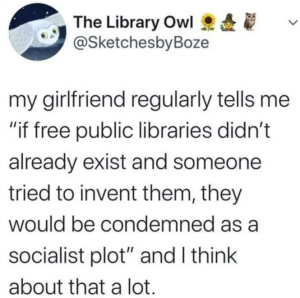There’s a Tweet that pops up every now and then on social media. It says, ‘my girlfriend regularly tells me “if free public libraries didn’t already exist and someone tried to invent them, they would be condemned as a socialist plot” and I think about that a lot.’

After learning about the New Models and all the ways public libraries have evolved into what they are now, I began to wonder: if public libraries didn’t already exist, what would I invent to take their place? Socialist bogeymen and taxpayer costs be damned–what does the community actually need? What does an ideal third space look like?
Other third spaces have been struggling. Many malls have closed or banned unaccompanied minors; affordable independent coffee shops have to hike prices up or get replaced by chains. And those spaces still center on purchases or outright require it, which not everyone can afford in order to have a safe space to be inside.
Libraries right now serve as lenders of books and other media, computer centers, reference desks, places for voting and tax information, and de facto daytime shelters. As Eric Klinenberg says, “libraries have become a crucial part of the safety net, the educational system, and the local democracy as well” (Gaetani, 2018). If I were to design something like that from the ground up, here’s what I would include:
- Designated sitting spaces for adults, children, and teens, at a variety of noise levels
- Play areas and short-term childcare spaces; children’s activities and storytime
- Bookable meeting rooms and community spaces for adults and teens
- Computers, printers, and tech help centers. Lendable laptops, ereaders, and hot spots, plus other tech as interest and community needs require
- A tool library: expensive, bulky, or infrequent use gadgets like IR cameras and power washers in addition to common needs like stud finders and hammers
- Makerspace, including 3D printers, sewing machines, and a laser cutter
- Community gardens with plots distributed for a year on a lottery system, as space allows
- A center with a social worker to connect those in need with services like homeless shelters, food pantries, and help with applying to benefits like SNAP and Medicaid
- A civic center with tax forms, voter registration forms, passport and license renewal forms
- Art galleries, bookable performance spaces, music practice rooms, podcasting studios…
- Regular community events. Tech help and tutorials. Book clubs, movie discussion clubs, board game clubs, writing groups, crafting clubs, trivia competitions, places to do puzzles…
- An area with small, inexpensive snacks and drinks. Not a full-on cafe, but coffee, tea, and simple food provided for free or for small donations/at cost.
- And, yes, lendable physical and digital media. Books, music, movies, video games. Include textbooks used by local schools where possible
I’m sure I’m missing a lot of possibilities–I’m only one person, with my own blind spots. But it is funny how much I can now imagine a library doing, when my own typical use cases are limited to borrowing books (and I use a lot of books!) and printing things. Thanks to the history of libraries, they will always be thought of as places for books and reading. But only by imagining what a community needs from the ground up can we make libraries expand to fit what those needs.
Reference
Gaetani, M. (2018, November 11). Q&A with Eric Klinenberg. Stanford University Center for Advanced Study in the Behavioral Sciences. https://casbs.stanford.edu/news/qa-eric-klinenberg
“What does an ideal third space look like?” This is a great question. I hadn’t thought about how I might design a third space until you posed the idea. I suppose we might be looking at the need to expand what libraries already offer in the near future, depending on how things move forward.
It might not be revolutionary but I think basic skills courses or maybe classes would be useful. I see younger people lament a lot of simple skills that they were just never taught (writing checks for example) or how to prepare food safely etc. That might fall under your community events umbrella.
I’m going to be thinking about this one for a while.
Great topic!
Thank you @bh553 ! Yes, libraries really are becoming a catch-all for social services. Your idea on basic life skills classes is really good too. I could also see classes on things like how to meal prep, basic personal finance and budgeting, car maintenance. There is so much that would help people out!
I adore this question. I love that you included a tool library and social workers. I would add a space for dancing!
@megan Love that!
I find it interesting to see your bullet points for what an ideal third space would look like, because a library somewhere at some time has probably provided that as a free service! Isn’t that wild to think about? I also think that in today’s world, we would all benefit from more third spaces, even if libraries could theoretically provide all the things. It’d be nice to walk from an art gallery to a booked meeting room to a cafe to a maker’s space and to end the day at my local library.
@doremimi Yes, that’s a great point! Libraries really have become a catch-all for all kinds of services. I really like your idea of a whole bunch of spaces for many purposes, but as more public services get demonized, I can’t see the trend of moving everything into the library reversing itself any time soon.